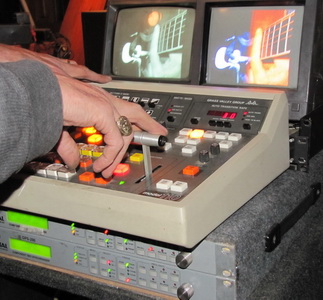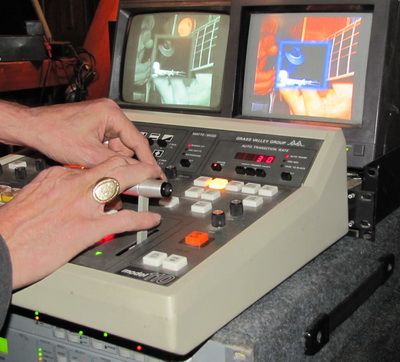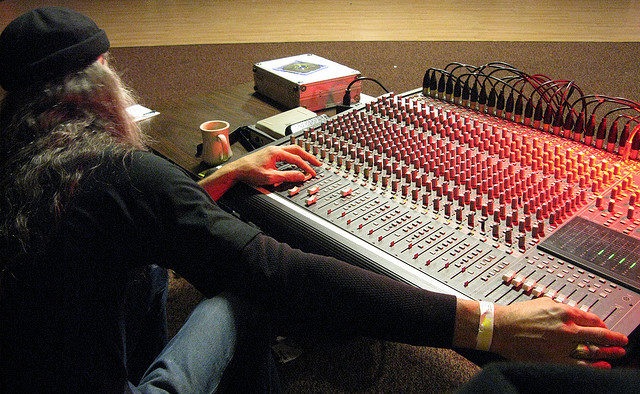| « Dan Grigor Thrown Out Of NAMM | Awesome Nobodies Play the Bay » |
Be a Hands-On Mixer
Take It From Me
by Edward Lapple
I just finished editing a music video for entry into a competition and I was struck by how much I missed some of the analog technology that used to be at our fingertips. Don’t get me wrong, I love all of the new digital toys! I’d be as quick to give them up as I would to leave Photoshop behind and return to smelly chemicals in dark rooms. I’m glad to have experienced it, but I’m even happier to be freed from the drudgery.
My current gripe concerns limitations imposed by nonlinear video editing systems that offer no control surfaces other than a mouse and pad.
This particular music video contained a lot of “B” roll footage collaged together. This wasn’t “B” roll of the band; these were shots from daily life that reinforced the vocal line. One of the artistic problems with “B” roll image collages like this is that, when you prepare it normally, you create something that can stand alone and present the story that the vocals are telling. In other words, you could slap the tune under the pictures that you have cut and be very happy with the result. You also have all of this great video of the band performing. They look wonderful on stage; you’ve got interesting camera angles and it cuts together really well into a performance video. So, how do you go about blending the two sets of footage together so you don’t lose the power that each one possesses?
I’m a writer that accepts being edited pretty easily, if I respect the editor. My late brother, on the other hand, was a writer who was ferociously protective of his material. I have seen him get into half-hour heated arguments over the suggestion that he change one word. He would defend that word and explain how it was the only word that made sense there; most of the time he would win the argument.
I’m that way with videos I edit. I have a reason for every shot that I put in and they are connected so that each enhances the storytelling. It generates quite an internal dilemma for me, therefore, when I have to switch from the “B” roll back to the band or visa-versa. I’m always in a quandary. I may have to go get a hair transplant just so that I’ll have some hair to pull out when I am faced with these situations.
One easy solution for me has always been the “Have-Your-Cake-and-Eat-It-Too” effect. Basically that’s a half-dissolve so that I can see both things at once. When I’m directing a live performance video, I use this effect all of the time. I can have the cameras position their shots so that the performers don’t overlap. Each camera subject enjoys their portion of the screen real estate and I can produce very striking multiple images.
If you’ve never done it, you have no idea how easy it is. You just grab the “T"-handle and pull it halfway through, then hold it in the middle for awhile. Drift a little up and you feature one performer, drift a little down and you feature the other. When the vocalist turns to the microphone, pull the handle all of the way through and he is solid, full-screen, the focus of the audience’s attention. It not only sounds simple, it is simple and occurs in real time. Now, I dare you, try that with your video editing software!
If you program a dissolve in an editor, there’s no way to stop it and hold it halfway through from the “Dissolve Dialogue,” so your only option is to go into the effects menu and vary the transparency values. Yes, you can hold it wherever you want using the animation function, and you can make it favor the “A” or the “B” video to any degree that you desire. To those, like me, who might scream, “What about the beat? How do you follow the beat?” the software guru would explain that, by looking at the waveform representation expanded on the audio track, you can match the beat with sub-frame precision. What you end up with is a robo-visual that took you 45 minutes to program and has a beat like a cop walking around the block. With a control handle you could have done it in fifteen seconds and it would have moved and pulsated to the beat. In the words of the “Duke” - not John Wayne silly, Duke Ellington - “It don’t mean a thing if it ain’t got that swing.” No truer words were ever spoken on that subject.
Please don’t get the idea that I’m against mice or computers because I’m not. My basic axiom with these machines has always been that they are tools to help me to accomplish my task more easily and, hopefully, better. I have no need for mechanisms which constantly place demands on my personal resources and require significantly more time than it would have taken me to do the job the old-fashioned way. OK, maybe I don’t care much for texting either, but I have fat fingers - that’s my excuse and I’m sticking to it!
Here’s another example of the musicality of a control surface in the audio world. The day before I started editing the music video I stopped in at Dan Grigor’s house by the lake. He’s gotten a new band together - “Live Music: Call For Info” - and they are starting to sound pretty good. He had a four-track recording done on a Tascam DA-88 and asked me if I’d like to mix it for a demo CD and, of course, I said, “Love to.” I’m such a glutton for working with good music!
The four tracks consisted of Dan’s Vocal, Dan’s Acoustic guitar, Michael Mountain’s Bass and Ric Tortorete’s Drums. I rolled the tape and set EQs so that the instruments weren’t bumping into each other sonically, and added some reverb to the guitar and vocals. As I was mixing, when a guitar solo came up I’d push it up a little bit and pull the unused vocal track back a bit, but then I heard an idea in my mind. I know that sounds weird but that’s what happens when you’re mixing.
It occurred to me that the vocal mic was picking up the acoustic guitar during the solo so I twisted a little more top EQ into it, increased the reverb send slightly and started panning it back and forth like a mad monkey to the beat. It was very subtle - well, as subtle as anyone with fat fingers can be - but it added a kind of swinging swagger to the solo with the reverb just swaying in the background like a reversible breeze, hooked to the beat. I kept it down and I doubt that anyone could identify what I was doing unless they read this article, but it added an audio three dimensionality to the sound and Dan liked what he heard. (He has good taste.) My point being: if I were mixing this on any kind of software system rather than a console with knobs, I never would have done this. It would have taken hours to program it and that “swing” I alluded to earlier? Well, I don’t think that you would have heard it there if it took that much effort to create the effect.
Now I am quite aware of the fact that a number of companies are marketing control surfaces which work in conjunction with the DAW packages. These range from single faders and a few knobs to enough faders that it would probably require three mix engineers, with arms fully extended to reach from one end of the console to the other. I have not had the opportunity to fly one of these setups in a real situation yet and you can bet that I will be haunting those booths at the next NAMM show. I will also make three other bets with you: 1. I’ll bet these devices return many of the physical mixing abilities that we have lost; 2. I’ll bet there will be a gang of interface problems as they attempt to work with the different DAW software packages; 3. I’ll bet that they are going to push the cost of mixing higher than that of a full-blown analog board.
That last bet is the unfortunate part because the ability to record and mix high-quality sound has been the emancipation of musicians. Today, pretty much anyone who can afford a guitar and an amplifier can afford their own digital studio to create their own productions. I’m hoping that someone will quickly figure out an economical way to make these control surfaces available to everyone.
We talked about this before. All that matters is how it sounds. Nobody gives a darn about how you mixed it except other mixers. If someone listens to your song and says, “Hey, great mix,” then it wasn’t, unless it was a song about mixing. My point being that we, as mixers, need to be aware of all of the tools of the trade and we need to apply them as we see fit to enhance the storytelling of the song or video. Unfortunately, the proliferation of “software only” approaches to replace mixing consoles is removing some very versatile tools from our toolbox. In our rush to the future, let’s not forget the sweet effects and techniques from our analog past.





